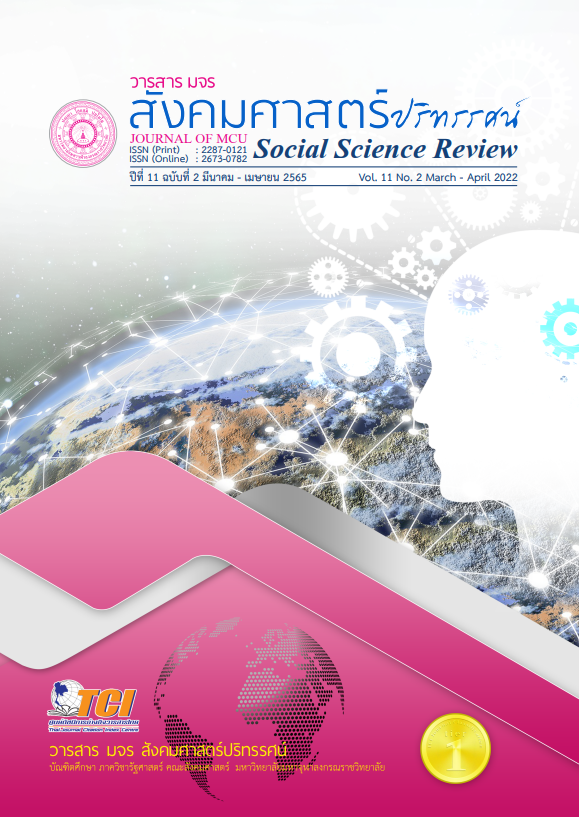THE DEVELOPMENT OF THE TEACHING AND LEARNING OF DHAMMA SCRIPTURES OF DHAMMA DIVISION OF SAMUTPRAKAN PROVINCE
Keywords:
Teaching and Learning Development, Dhamma Scriptures of Dhamma, SanghaAbstract
Objectives of this article were to analyze the general condition, process and to present the development of Dhamma learning and teaching conducted with the mixed methods; The qualitative research method collected data from 20 key informants by in-depth-interview and 10 participants in focus group discussion and analyzed data by content descriptive interpretation. The quantitative method collected data from 181 samples from 273 students and analyzed data with frequency, percentiles, means and standard deviation, SD.
The research findings were as follow; 1. The Sangha of Samut Prakan Province was a continuous promotion and development of the teaching of the Buddha Dharma. Educational personnel had good knowledge and ability to teach. Organizing a summer novice ordination activity and encouraging students to participate in the Dharma during the project. 2. Processes including planning, organizing Personnel management, administration, coordination, reporting and when surveying the opinions of the samples were found that the opinions were at a moderate level ( = 3.10, S.D. = 0.826), and when considering each aspect, it was found that the opinions were at a moderate level in all aspects. 3. Development, including the development of a modern curriculum for the Dharma department by making the textbook interesting. Organizing content and activities in accordance with learners’ needs. Teaching and learning that combines knowledge and morality in teaching media. The use of teaching materials that were suitable for the lesson made it interesting and interesting to learn.
References
กรมการศาสนา. (2526). แบบเรียนวิชาสาวกประวัติ. กรุงเทพฯ: โรงพิมพ์การศาสนา.
พระครูวิสุทธิ์ธรรมานุวัตร (สมเกียรติ วิสุทฺโธ). (2561). รูปแบบการส่งเสริมการศึกษาพระปริยัติธรรมจังหวัดชลบุรี (ดุษฎีนิพนธ์พุทธศาสตรดุษฎีบัณฑิต สาขาการจัดการเชิงพุทธ). พระนครศรีอยุธยา: มหาวิทยาลัยมหาจุฬาลงกรณราชวิทยาลัย.
พระครูศรีอรรถศาสก์ มหาอตฺโถ. (2560). การพัฒนาประสิทธิภาพการจัดการศึกษาพระปริยัติธรรมแผนกบาลีของคณะสงฆ์ ภาค 14. วารสาร มจร สังคมปริทรรศน์, 6(2) ฉบับพิเศษ, 239-240.
พระปลัดปรีชา นนฺทโก (จุลเจือ). (2560). การศึกษาแนวทางการพัฒนาศักยภาพพระสอนศีลธรรมโรงเรียนมัธยมศึกษาสังกัดสำนักงานคณะกรรมการการศึกษาขั้นพื้นฐานในจังหวัดระยอง (ดุษฎีนิพนธ์พุทธศาสตรดุษฎีบัณฑิต สาขาวิชาพระพุทธศาสนา). พระนครศรีอยุธยา: มหาวิทยาลัยมหาจุฬาลงกรณราชวิทยาลัย.
พระมหาอัมราช อมรเสวี (เหมัง). (2561). การศึกษาแนวทางการพัฒนาการเรียนการสอนของครูและนักเรียนสำนักเรียนพระปริยัติธรรมแผนกธรรม กรุงเทพมหานคร. วารสารครุศาสตร์ปริทรรศน์ฯ, 5(3), 199-200.
สำนักงานเจ้าคณะจังหวัดสมุทรปราการ. (2562). บัญชีรายชื่อผู้เข้าสอบนักธรรมปี 2562. สมุทรปราการ : สำนักงานเจ้าคณะสมุทรปราการ.
สุภาพร มากแจ้ง และสมปอง มากแจ้ง. (2543). การศึกษาสภาพการจัดการศึกษาของคณะสงฆ์. กรุงเทพฯ: กรมการศาสนา.
Downloads
Published
How to Cite
Issue
Section
License
Copyright (c) 2022 Journal of MCU Social Science Review

This work is licensed under a Creative Commons Attribution-NonCommercial-NoDerivatives 4.0 International License.
In order to conform the copyright law, all article authors must sign the consignment agreement to transfer the copyright to the Journal including the finally revised original articles. Besides, the article authors must declare that the articles will be printed in only the Journal of MCU Journal of Social Sciences. If there are pictures, tables or contents that were printed before, the article authors must receive permission from the authors in writing and show the evidence to the editor before the article is printed. If it does not conform to the set criteria, the editor will remove the article from the Journal without any exceptions.





